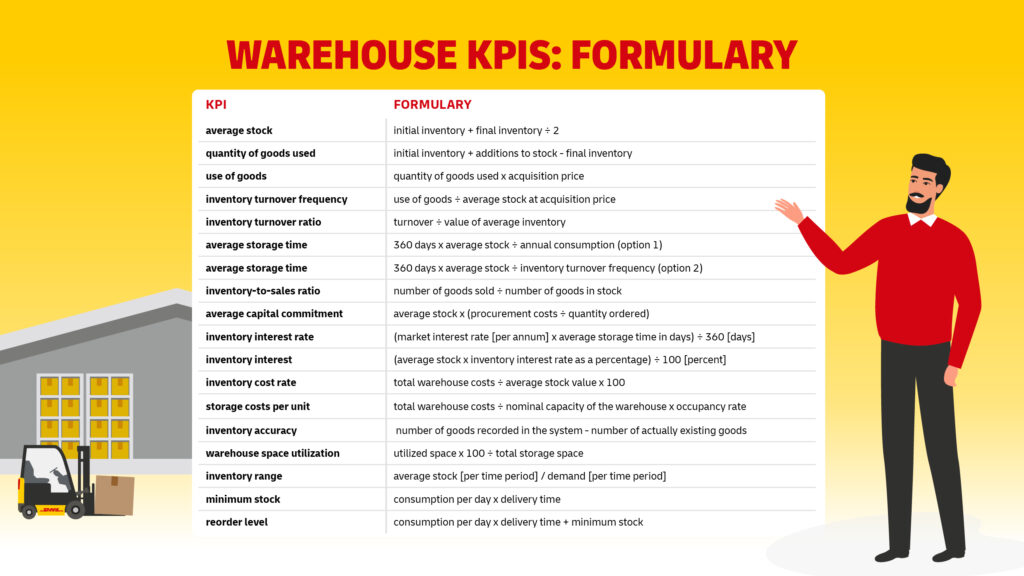
Key performance indicators (KPIs) for warehouse logistics and, above all, their targeted interpretation provide information about the efficiency of a warehouse. KPIs for warehousing show which adjustments companies should make to work more economically in the warehouse and in general. What are the most important inventory KPIs and how are they calculated? This overview provides information.
What are Warehouse KPIs?
Warehouse KPIs – sometimes referred to as warehouse performance KPIs, inventory KPIs, or inventory management KPIs – are measurable figures for the quality of warehouse logistics processes and the efficiency of a warehouse. They provide precise information about the current state of a company’s warehouse logistics.
Warehouse KPIs make it possible to determine the efficiency of individual work steps and to identify those areas where the actual value deviates from the target value. If deficient processes are improved, warehouse lead times can be accelerated, and costs reduced.
The Functions of Warehouse KPIs
The first function of warehouse KPIs is in monitoring: this is to be as comprehensive as possible to detect inefficient or faulty processes in the warehouse.
For instance, the following questions are addressed:
- How many goods are in stock on average and for how long?
- How much capital is tied up in inventory and how much cost is incurred for storage?
- What is the ratio of storage cost to the average inventory?
- Do stocks cover consumption?
The second function is of a strategic nature: warehouse KPIs provide the basis for logistical decisions so that processes in the company’s own warehouse can be made more cost-effective.
The Most Important Warehouse KPIs with Calculation Formulas
Average Stock
This inventory KPI indicates how many goods the company keeps in stock on average. It gives direct information about the inventory costs and the capital commitment, each of which results from the inventory.
How to calculate the average stock KPI:
average stock = initial inventory + final inventory ÷ 2
Use of Goods
The KPI for the use of goods provides on the one hand information on the value of goods that have been sold or processed by a company. On the other hand, this key figure is used to determine the storage turnover frequency.
To calculate this KPI, the additions to stock must first be added to the initial inventory at the beginning of the year. Then the final inventory at the end of the year is subtracted. This results in the quantity of goods used. To express the figure as a monetary unit, the quantity of goods used must be multiplied by the acquisition price.
How to calculate the KPI for the quantity of goods used:
quantity of goods used = initial inventory + additions to stock - final inventory
How to calculate the KPI for use of goods:
use of goods = quantity of goods used x acquisition price
Inventory Turnover Frequency
The KPI for inventory turnover frequency can be determined for the entire warehouse as well as for individual product groups or articles. It indicates how often the respective stock enters or leaves the warehouse. A low inventory turnover frequency reflects a low level of demand or limited further utilization in the company. Therefore, a high inventory turnover frequency (at least 0.5) is critical for warehouse efficiency.
How to calculate the KPI for storage turnover frequency:
inventory turnover frequency = use of goods ÷ average stock at acquisition price
Inventory Turnover Ratio
The inventory turnover frequency may also be specified as inventory turnover ratio which is also used to analyze the turnover of inventory in a certain period of time.
The inventory turnover ratio is usually applied to a specific product in stock. This shows how often this particular product leaves the warehouse and is replaced by new stock. The higher the inventory turnover ratio, the more frequently a particular product is sold and reordered. Low inventory turnover ratios indicate excess stock in the warehouse – and on the other hand, high ratios prove that the company’s capital is being used effectively. This is because a high inventory turnover ratio indicates that inventories are being held adequately and thus cost-effectively.
How to calculate the KPI for the inventory turnover ratio:
inventory turnover ratio = turnover ÷ value of average inventory
Average Storage Time
Goods that are neither sold nor processed and instead stay in the warehouse unused cause higher costs than goods that pass through quickly. The KPI for storage time can be used to detect how long inventories remain in the warehouse on average. The higher the value, the higher the capital commitment. For this reason, the shortest possible storage time is an important logistics objective.
How to calculate the KPI for average storage time:
option 1: average storage time = 360 days x average stock ÷ annual consumption
option 2: average storage time = 360 days x average stock ÷ inventory turnover frequency
Inventory-to-sales Ratio
This KPI provides information on how much of the stock is sold. In this way, an undersupply or excess inventory can be identified. If the inventory-to-sales ratio indicates high sales, there is demand that could exceed inventory. It is important to respond to this. The inventory-to-sales ratio, together with inventory turnover frequency, inventory turnover ratio or average storage time, gives a good picture of the demand situation.
How to calculate the KPI for the inventory-to-sales ratio:
inventory-to-sales ratio = number of goods sold ÷ number of goods in stock
Average Capital Commitment
Capital is required to finance stock. It is tied up in the warehouse until a respective good leaves the warehouse again. During this time, the capital is not available for other purposes. This restricts the liquidity of a company, which is why this figure should be as low as possible.
How to calculate the KPI for average capital commitment:
average capital commitment = average stock x (procurement costs ÷ quantity ordered)
Inventory Interest and Inventory Interest Rate
These two key figures illustrate the costs for a company caused by the capital tied up in the warehouse. Both key figures are directly related, whereby the inventory interest rate is required for the calculation of the inventory interest.
How to calculate the inventory interest rate:
inventory interest rate = (market interest rate [per annum] x average storage time in days) ÷ 360 [days]
How then to calculate the inventory interest:
inventory interest = (average stock x inventory interest rate as a percentage) ÷ 100 [percent]
Inventory Cost Rate
The inventory cost rate represents the total cost of a warehouse in relation to the average stock. For this purpose, all costs associated with the warehouse are accounted for: e.g., personnel costs, building maintenance, acquisition and maintenance of vehicles and equipment, energy costs, or depreciation.
How to calculate the inventory cost rate:
inventory cost rate = total warehouse costs ÷ average stock value x 100
Storage Costs per Unit
The inventory cost rate for the entire warehouse is complemented by the storage costs per unit: what costs are incurred for the specific inventories? This is a meaningful indicator of warehouse costs which allows inefficient processes in the warehouse to be identified and ultimately reduces overall costs.
How to calculate the KPI for storage costs per unit:
storage costs per unit = total warehouse costs ÷ nominal capacity of the warehouse x occupancy rate
Inventory Accuracy
If the actual stock does not match the inventory in the ERP system, additional costs and accounting problems may arise. In addition, the quality of service suffers, as commitments to customers may not be met. For this reason, inventory accuracy is an important performance indicator in warehouse logistics.
To avoid negative effects as much as possible, the deviations should be minimal. The stock accuracy indicator specifies how large the discrepancy between recorded in the ERP system and the goods present in the warehouse actually is. The ideal value here is 0.
How to calculate the KPI for inventory accuracy:
inventory accuracy = number of goods recorded in the system - number of actually existing goods
Warehouse Space Utilization
Only an efficiently utilized warehouse is economical. Overcapacities generate additional costs, which are reflected in the performance indicators for storage costs.
Is the available capacity being used appropriately? What is the ratio of available and actually used space? Answers to these questions, which are provided by the KPIs, identify opportunities to improve space utilization – for example, with synchronized inbound and outbound goods management.
How to calculate the KPI for warehouse space utilization:
warehouse space utilization = utilized space x 100 ÷ total storage space
Inventory Range
The KPI for inventory range determines how long the stock will last in the case of average demand or average material consumption. Thus, the question is: does the stock level correspond to the demand and for how long? The inventory range indicator enables decisions on necessary measures, such as reordering, new production, or switching suppliers. Sufficient inventory range is crucial for the success of a company.
How to calculate the KPI for inventory range:
inventory range = average stock [per time period] / demand [per time period]
Minimum Stock
The minimum stock is closely related to the inventory range. It is the minimum quantity that has to be in stock to cover requirements. A solid minimum stock level indicates that even in the case of unforeseen events, such as problems in the supply chain, the stock will be sufficient.
How to calculate the KPI for minimum stock:
minimum stock = consumption per day x delivery time
Reorder Level
The reorder level KPI tells you when goods need to be reordered to meet the required minimum stock level. If this figure is too low, there is a risk that business processes will be interrupted or orders cannot be delivered. There is a threat of losing customers.
How to calculate the KPI for the reorder level:
reorder level = consumption per day x delivery time + minimum stock

Warehouse KPIs: Formulary
average stock = initial inventory + final inventory ÷ 2
quantity of goods used = initial inventory + additions to stock - final inventory
use of goods = quantity of goods used x acquisition price
inventory turnover frequency = use of goods ÷ average stock at acquisition price
inventory turnover ratio = turnover ÷ value of average inventory
average storage time = 360 days x average stock ÷ annual consumption (option 1)
average storage time = 360 days x average stock ÷ inventory turnover frequency (option 2)
inventory-to-sales ratio = number of goods sold ÷ number of goods in stock
average capital commitment = average stock x (procurement costs ÷ quantity ordered)
inventory interest rate = (market interest rate [per annum] x average storage time in days) ÷ 360 [days]
inventory interest = (average stock x inventory interest rate as a percentage) ÷ 100 [percent]
inventory cost rate = total warehouse costs ÷ average stock value x 100
storage costs per unit = total warehouse costs ÷ nominal capacity of the warehouse x occupancy rate
inventory accuracy = number of goods recorded in the system - number of actually existing goods
warehouse space utilization = utilized space x 100 ÷ total storage space
inventory range = average stock [per time period] / demand [per time period]
minimum stock = consumption per day x delivery time
reorder level = consumption per day x delivery time + minimum stock
Warehouse KPIs are valuable means of identifying and correcting deficits in the warehouse so that capacities can be used efficiently and economically. However, not every KPI has the same informative value for every industry. Turnover ratios may be considerably higher in the agricultural sector, for example, than in the trade of luxury goods. In the latter case, a lower turnover rate does not necessarily represent a business problem. In addition, there are also very different and industry-specific space or personnel requirements.
That is why the specific interpretation of warehouse KPIs is just as important as recording them. As DHL Freight and DHL Group, we are happy to support you in this.


